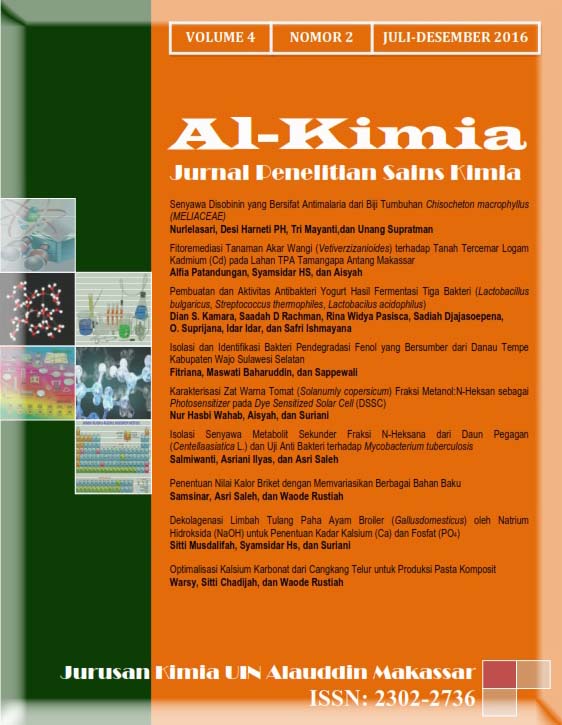Senyawa Disobinin yang Bersifat Antimalaria dari Biji Tumbuhan Chisocheton macrophyllus (Meliaceae)
Abstract
Disobinin compounds have been isolated from the seeds Chisocheton macrophyllus (Meliaceae). The chemical structure of compounds disobinin identified based on data covering UV spectroscopy, IR, 1D-NMR, 2D-NMR and mass spectra as well as the comparison with the data obtained from the literature. Disobinin compound showed antimalarial effect against P. falcifarum with IC50 values from 0.001 to 0.01 mg/mL . Limonoids compound, disobinin reported for the first time in the genus of Chisocheton.
Downloads
References
Awang, K., Lim, C.S., Mohamad K., Morita, H., Hirasawa, Y., Takeya, K., Thoison, O.,and Hadi, A.H.A., 2007.
Erythrocarpines A-E, new cytotoxic limonoids from Chisochetonerytrocarpus, Bioorg Med Chem, 15: 5997-6002.
Bray, D.H., Warhurst, D.C., Conolly, J.D., O’Neil, M.J., and Philipson, J.D., 1990, Plants as source of antimalarial drug. Pt. 7 activity of some species Meliaceae plants and their constituent limonoids. Phytother Res, 4:29-35.
Heyne, K., 1987, The Useful Indonesian Plants, Research and Development Agency, Ministry of Forestry, Jakarta Indonesia.
Inada, A., Sukemawa, M., Murata, H., Nakanishi, T., Tokuda, H., Nishino, H., Iwashima, A., Darnaedi, D.,and Murata, J.,1993, Phytochemical studies on Maleaceous Plant. Part VIII. Structures and Inhibitory Effects on Epstein-Barr Virus Activation of Triterpenoids from Leaves of Chisocheton macrophyllus King, Chem Pharm Bull, 41: 617-619.
Laphookhieo, S., Maneerat, W., Koysomboon, S., Kiattansakul, R., Chantrapromma, K.,and Syers, J.K., 2008. A Novel Limonoid from the seeds of Chisocheton siamensis,Can J Chem,86: 205-208.
Maneerat, W., Laphookhieo, S., Syers, J.K., Kiattansakul., Koysomboon, S., and Chantrapromna, K., 2008, Antimalaria, Antimicobacterial and Cytotoxic limonoid from Chisocheton siamensis, Phytomedicine,15: 1130-1135.
Mohamad, K., Hirasawa,Y., Lim C.S., Awang, K., Hamid, A., Hadi, A., Takeya, K.,and Morita, H.,2008, Ceramicines A and walsogyne A novel limonoids from two species of Meliaceae, Tetrahedron Letter, 49: 4276–4278.
Mohamad, K., Hirasawa,Y., Litaudon, M., Awang, K., Hamid, A., Hadi, A., Takeya, K., Ekasari, W., Widyawaruyanti, A., Zaini, N.C.,and Morita, H.,2009, Ceramicines B–D, new antiplasmodial limonoids from Chisocheton ceramicus, Bioorganic & Medicinal Chemistry, 17: 727-730.
Omar, S., Zhang, J., MacKinnon, S., Leaman, D., Durst, T., Philogene, BJ., Anarson, JT., Sanchez-Vindas, PE., Poveda, L., Tamez, PA.,and Pezzuto, JM., 2003, Traditionally-used antimalarials from Meliaceae, Curr Top Med Chem,3(2): 133-9.
Parmar, B.S., 1995, Results with commercial neem formulations produced in India. In H. Schmutterer (ed.), The neem tree Azadirachtaindica A. Juss. And other Meliaceous plants. Sources of unique natural products for integrate pest managemant, medicine, industry and other purposes, VCH Tokyo, pp. 453-470.
Phongmaykin, J., Kumamoto, T., Ishikawa, T., Suttisri, R,, and Saifah, E., 2008. A New Sesquiterpene and Other Terpenoid Constituents of Chisochetonpenduliflorus, Arch Pharm Res,31: 1.
Wong, C.P., Shimada, M., Nagakura, Y., Nugroho, A.E., Hirasawa, Y., Kaneda, T., Awang, K., Hamid, A., Hadi, A., Mohamad, K., Shiro, M.,and Morita, H., 2011, Ceramicines E-I, New Limonoids from Chisocheton ceramicus, Chem Farm Bull,59: 407-411.
Yang, MH., Wang, JS., Luo, JG., Wang, XB.,and Kong, LY., 2009, Tetranortriterpenoids from Chisocheton paniculatus, Journal Nat Pro,72: 2014-2018.
Yang, M.H., Wang J.S., Luo J.G., Wang X.B., and Kong L.Y., 2011.
Chisopanins A-K, 11 New newprotolimonoids from Chisocheton paniculatus and their anti-inflammatory activities, Bioorganic & Medicinal Chemistry,19: 1409-1417.
Copyright (c) 2016 Al-Kimia

This work is licensed under a Creative Commons Attribution-NonCommercial-ShareAlike 4.0 International License.
Authors who publish with this journal agree to the following terms:
1) Authors retain copyright and grant the journal right of first publication with the work simultaneously licensed under a Creative Commons Attribution License that allows others to share the work with an acknowledgement of the work's authorship and initial publication in this journal.
2) Authors are able to enter into separate, additional contractual arrangements for the non-exclusive distribution of the journal's published version of the work (e.g., post it to an institutional repository or publish it in a book), with an acknowledgement of its initial publication in this journal.
3)Authors are permitted and encouraged to post their work online (e.g., in institutional repositories or on their website) prior to and during the submission process, as it can lead to productive exchanges, as well as earlier and greater citation of published work (See The Effect of Open Access).


